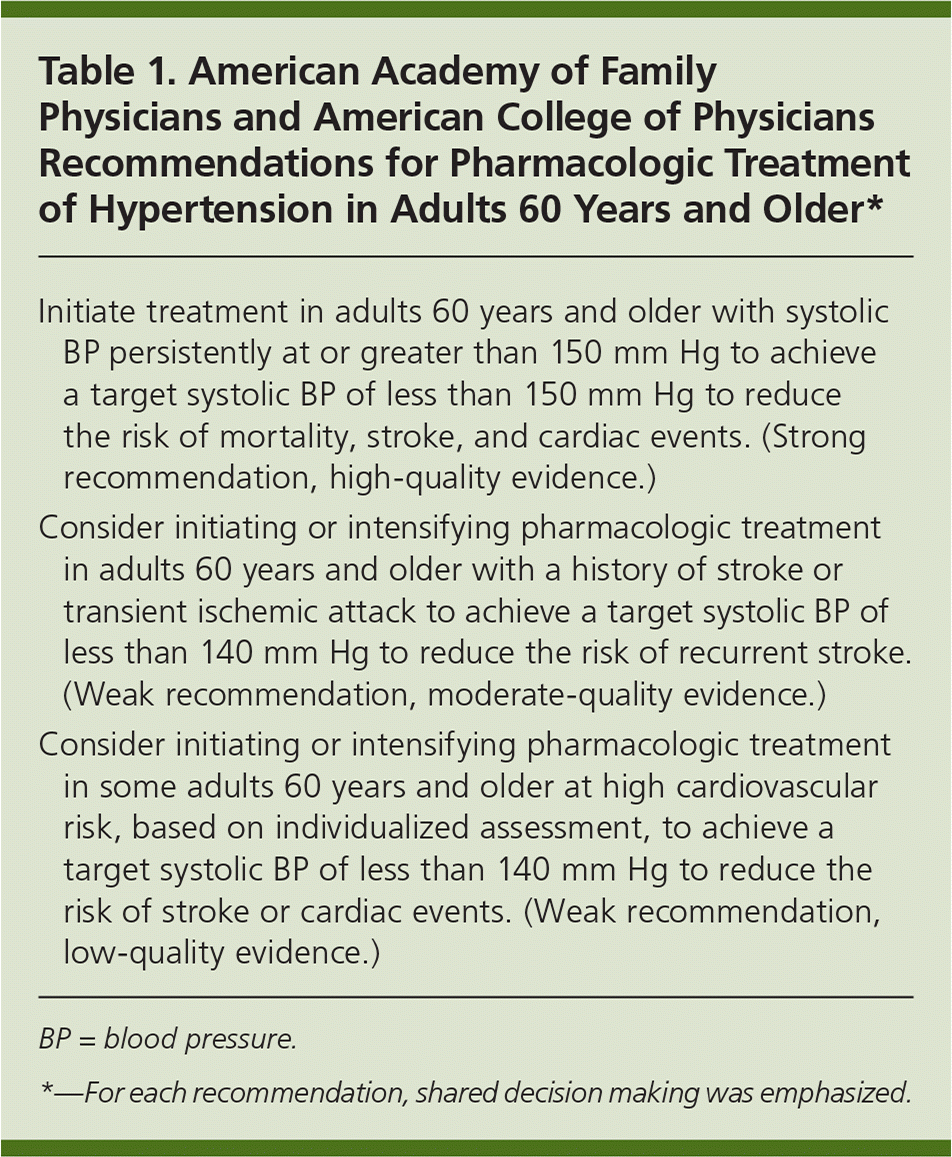
Am Fam Physician. 2017;95(9):547-548
Related Practice Guideline: Pharmacologic Treatment of Hypertension: ACP and AAFP Release Recommendations for Adults 60 Years and Older.
Author disclosure: No relevant financial affiliations.
Preventive medications treat asymptomatic individuals at risk of a disease, rather than those diagnosed with a disease. A high standard must be met when guidelines recommend lifelong preventive medications, knowing that at best, a small minority of patients will benefit and that all are risking harm. Such decisions should be informed by good evidence that the benefits outweigh the harms, and clinical guidelines that inform those decisions should be rigorously developed, evidence based, and trustworthy. It is in that context that guidelines for the management of hypertension should be evaluated.
The American Academy of Family Physicians (AAFP) and the American College of Physicians (ACP) have collaborated on a clinical guideline for the treatment of hypertension in adults 60 years and older,1 summarized in this issue of American Family Physician.2 Before considering the specific recommendations, it is useful to ask whether this panel adhered to the standards set by the Institute of Medicine (IOM) in their report on “Clinical Practice Guidelines We Can Trust.”3 The AAFP/ACP guideline effort followed a transparent process, eliminated potential financial and intellectual conflicts of interest, used external systematic evidence reviews, and followed the GRADE (Grading of Recommendations Assessment, Development and Evaluation) methodology to evaluate evidence and rate the recommendations. General internal medicine and family medicine were represented on the panel. Input from other subspecialties appears to be limited to those on the ACP Clinical Guidelines Committee. The guideline is considered out of date after five years or if replaced earlier. External review was provided through the AAFP and ACP, as well as the Annals of Internal Medicine peer review process. In short, the guideline panel should be commended for following the IOM standards. Based on a review of their process, the panel has produced a guideline we can trust.
The panel convened by the National Heart, Lung, and Blood Institute in 2008 as the Eighth Joint National Committee (JNC 8) followed a similar process, and a grade A recommendation was given to treat adults 60 years and older to a target systolic blood pressure (BP) of 150 mm Hg.4 This recommendation, however, was not unanimous, and there was pushback from some in the hypertension and cardiovascular communities.5 Since the publication of the JNC 8 guideline, a large randomized controlled trial, SPRINT (Systolic Blood Pressure Intervention Trial), compared persons with a systolic BP goal of 120 mm Hg and those with a goal of 140 mm Hg.6 The results favored the more aggressive target, with lower rates of a composite of cardiovascular events and all-cause mortality. It is in this setting that the current guideline panel reviewed existing trial evidence to reach the conclusions summarized in Table 1.

| Initiate treatment in adults 60 years and older with systolic BP persistently at or greater than 150 mm Hg to achieve a target systolic BP of less than 150 mm Hg to reduce the risk of mortality, stroke, and cardiac events. (Strong recommendation, high-quality evidence.) |
| Consider initiating or intensifying pharmacologic treatment in adults 60 years and older with a history of stroke or transient ischemic attack to achieve a target systolic BP of less than 140 mm Hg to reduce the risk of recurrent stroke. (Weak recommendation, moderate-quality evidence.) |
| Consider initiating or intensifying pharmacologic treatment in some adults 60 years and older at high cardiovascular risk, based on individualized assessment, to achieve a target systolic BP of less than 140 mm Hg to reduce the risk of stroke or cardiac events. (Weak recommendation, low-quality evidence.) |
The AAFP/ACP guideline makes a strong recommendation to treat adults 60 years and older to a systolic BP of less than 150 mm Hg. A weak recommendation is made to treat those in this age group at high cardiovascular risk to a systolic BP of less than 140 mm Hg. The panel found the body of evidence supporting a lower BP target to be of low quality. The background evidence review noted inconsistent trial results, with imprecise estimates of benefit that encompassed the possibility of marked benefit and no effect. The evidence was most consistent for a reduction in stroke, with an absolute risk reduction of 0.49% and a number needed to treat of 204. The results for mortality were nonsignificant. There was a marginally significant reduction in cardiac events with a number needed to treat of 106.
It is safe to predict that others examining this literature will not reach the same conclusion; this may be based on preexisting beliefs or advocacy positions. We can anticipate the results of the SPRINT trial will be used to encourage support for systolic BP targets even lower than 140 mm Hg. How should we respond in practice? This is a clinical practice guideline we can trust. Our systolic BP goal for adults 60 years and older should be 150 mm Hg or lower, and quality measures should reflect this target. On an individual basis, achieving a lower systolic BP for those at increased cardiovascular risk is reasonable if it can be safely and easily accomplished considering comorbidity, risk of adverse events, medication burden, and cost. As we discuss a lower goal BP with our patients, we must keep in mind that we are treating asymptomatic persons with medication, usually for the rest of their lives, knowing that at best, a very small minority will actually benefit.
